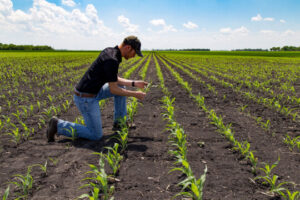Read the latest information on
Foot-and-mouth disease
Biosecurity is essential to the success and sustainability of your farm. While growers work hard to protect crops from plant pests and diseases, unexpected threats like extreme weather events and the movement of people, equipment, vehicles, and wildlife, can introduce unintended risks on-farm.
A farm biosecurity plan is an essential investment in your farm’s resilience, productivity and reputation. It extends beyond individual farms to benefit the broader Australian agricultural sector, economy, environment, and society.
A well-prepared farm biosecurity plan is an essential tool to help protect your farm from the introduction and spread of pests, diseases, and weeds that can significantly impact productivity, profitability, and sustainability. Having a farm biosecurity plan is critical to safeguard productivity, minimise losses, protect market access, reduce environmental risks, manage emerging threats and to promote sustainable practices.
Biosecurity is also vital for maintaining access to the agriculture markets, both within Australia and internationally. Australia is free from many serious grain pests and diseases found overseas, putting Australian growers in a strong position to trade both domestically and internationally. Having a farm biosecurity plan makes good business sense.
To get started, download the Farm Biosecurity Plan for Grain Producers template from grainsbiosecurity.com.au.
The farm biosecurity planner will help assess the biosecurity risks on your farm and illustrate steps to address them. Refer to the planner periodically to check on progress and prioritise actions. If you build your plan around daily, monthly or yearly farm routines, then biosecurity should become a habit. After you have ranked your priorities, think about which ones you can achieve in the short and long term. Go back to the plan periodically and check progress towards your goals.
A good biosecurity plan focuses on six key areas to minimise risks, focusing on the most significant threats. Effective biosecurity practices do not have to be expensive to implement, but they do need to be easy to follow.
Monitor materials entering your farm, such as seeds, fertilisers, feed, and equipment. These could carry pests or diseases. Purchase certified seed from reputable suppliers, and ensure fertilisers are tested for pathogens or pests before use. Always inspect deliveries for signs of pests, such as sawdust or frass.
Biosecurity does not end at the farm gate. Ensure that products leaving your farm, like hay or grain, are free of pests. Keep grain loading and unloading areas away from production areas to avoid contamination. Secure plant material during transport and maintain records of outgoing movements for traceability in the event of an incursion.
Visitors to your farm can carry pests and diseases on their clothes, equipment, and vehicles. Display biosecurity signs at all entrances to your property. Consider creating a designated parking area away from production areas. Be mindful of high-risk visitors, such as those who have recently been overseas or to other farms. Clean equipment regularly to reduce the risk of introducing pests and diseases.

Image: Orange rust spores on clothing. Clean with disinfectant or change your clothing to reduce the spread of disease.
Maintaining good farm hygiene is essential for preventing pests and diseases. Regularly inspect your crops for early signs of plant pests or diseases and keep detailed inspection records. Monitor and clean grain storage areas to prevent infestations by pests like weevils or borers. When harvesting, start with the cleaner paddocks and leave the dirtier ones until last.

Regular crop monitoring is a good way detect pests and diseases before they establish
Weeds and volunteer plants often act as hosts for plant pests and diseases, especially during off-seasons. Controlling these “green bridges” prevents early build-up of pests and diseases, reduces weeds and helps preserve soil moisture.
Train your workers on biosecurity practices and how to identify pests and diseases. This knowledge enables them to spot anything unusual and report potential biosecurity threats. Document all training sessions and offer refresher courses from time to time to keep everyone up to date on biosecurity procedures.
If you see something unusual, take a picture and record the date and location. Mark the location with a peg or surveyor’s tape. Contact the Exotic Plant Pest Hotline at 1800 084 881 to report it within 24 hours.